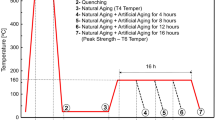Abstract
The effects of a thermal residual stress field on fatigue crack growth in a silicon carbide particle-reinforced aluminum alloy have been measured. Stress fields were introduced into plates of material by means of a quench from a solution heat-treatment temperature. Measurements using neutron diffraction have shown that this introduces an approximately parabolic stress field into the plates, varying from compressive at the surfaces to tensile in the center. Long fatigue cracks were grown in specimens cut from as-quenched plates and in specimens which were given a stress-relieving overaging heat treatment prior to testing. Crack closure levels for these cracks were determined as a function of the position of the crack tip in the residual stress field, and these are shown to differ between as-quenched and stress-relieved samples. By monitoring the compliance of the specimens during fatigue cycling, the degree to which the residual stresses close the crack has been evaluated.
Similar content being viewed by others
References
T.W. Clyne and P.J. Withers:An Introduction to Metal Matrix Composites, Cambridge University Press, Cambridge, United Kingdom, 1993.
D.L. Davidson:Metall. Trans. A, 1987, vol. 18A, pp. 2115–28.
J.K. Shang, W. Yu, and R.O. Ritchie:Mater. Sci. Eng., 1988, vol. 102A, pp. 181–92.
D.M. Rnowles, T.J. Downes, and J.E. King:Acta Metall. Mater., 1993, vol. 41, pp. 1189–96.
D.M. Knowles and J.E. King:Mater. Sci. Technol, 1991, vol. 7, pp. 1015–20.
R.O. Ritchie and K.J. Bathe:Int. J. Fract., 1979, vol. 15, pp. 47–55.
W.F. Deans and C.E. Richards:J. Test. Eval, 1979, vol. 7, pp. 147–54.
N.A. Fleck: Ph.D. Thesis, University of Cambridge, Cambridge, United Kingdom, 1984.
W. Elber:Eng. Fract. Mech, 1970, vol. 2, pp. 37–45.
S. Suresh:Fatigue of Materials, Cambridge University Press, Cambridge, United Kingdom, 1991.
M.N. James and J.F. Knott:Mater. Sci. Eng., 1985, vol. 72, pp. Ll- L4.
A.J. Allen, M.T. Hutchings, C.G. Windsor, and C. Andreani:Adv. Phys., 1985, vol. 34, pp. 445–73.
M.E. Fitzpatrick, T.J. Downes, M.T. Hutchings, J.E. King, D.M. Knowles, and P.J. Withers:9th Int. Conf. on Composite Materials, A. Miravete, ed., University of Zaragoza/Woodhead Publishing, Cambridge, UK, 1993, vol. 1, pp. 642–49.
M.T. Hutchings: Report No. AEA-InTec-1289, AEA Industrial Technology, Harwell, United Kingdom, 1993.
R.B. Hill and H.J. Axon:J. Inst. Met., 1954, vol. 83, pp. 354–56.
H.G. Priesmeyer: inMeasurement of Residual and Applied Stress Using Neutron Diffraction, M.T. Hutchings and A.D. Krawitz, eds., Kluwer Academic Publishers, London, 1992, pp. 277–84.
B. Roebuck:Fatigue Fract. Eng. Mater. Struct., 1992, vol. 15, pp. 13–22.
M.E. Fitzpatrick, M.T. Hutchings, and P.J. Withers:Phys. B, 1995, vol. 213, pp. 790–92.
M.E. Fitzpatrick, T.J. Downes, M.T. Hutchings, D.M. Knowles, J.E. King, and P.J. Withers:4th Int. Conf. on Residual Stresses, Society for Experimental Mechanics, Bethel, CT, 1994, pp. 559–68.
P.J. Withers, A.P. Clarke, and M.E. Fitzpatrick: inIntrinsic and Extrinsic Fracture Mechanisms in Inorganic Composite Systems, J.J. Lewandowski and W.H. Hunt, Jr., eds., TMS, Warrendale, PA, 1995, pp. 49–56.
M.P. Thomas, D.M. Knowles, and J.E. King:Euromat 91: 2nd Eur. Conf. on Advanced Materials and Processes, T.W. Clyne and P.J. Withers, eds., Institute of Materials, London, 1991, vol. 2, pp. 105- 16.
A.M. Korsunsky, M.E. Fitzpatrick, and P.J. Withers:10th Int. Conf. on Composite Materials, A. Poursatip and K. Street, eds., Woodhead Publishing, Cambridge, UK, 1995, vol. 1, pp. 545–52.
H.-C. Choi and J.-H. Song:Fatigue Fract. Eng. Mater. Struct., 1995, vol. 18, pp. 105–17.
K.J. Kang, J.H. Song, and Y.Y. Earmme:Fatigue Fract. Eng. Mater. Struct, 1990, vol. 13, pp. 1–13.
M.E. Fitzpatrick: Ph.D. Thesis, University of Cambridge, Cambridge, United Kingdom, 1995. $
Author information
Authors and Affiliations
Additional information
formerly Research Student, Department of Materials Science and Metallurgy, University of Cambridge
formerly Lecturer, Department of Materials Science and Metallurgy, University of Cambridge
This article is based on a presentation made in the symposium entitled “Creep and Fatigue in Metal Matrix Composites” at the 1994 TMS/ASM Spring meeting, held February 28–March 3, 1994, in San Francisco, California, under the auspices of the Joint TMS-SMD/ASM-MSD Composite Materials Committee.
Rights and permissions
About this article
Cite this article
Fitzpatrick, M.E., Hutchings, M.T., King, J.E. et al. Effect of thermal residual stresses on fatigue crack opening and propagation behavior in an Al/SiC p metal matrix composite. Metall Mater Trans A 26, 3191–3198 (1995). https://doi.org/10.1007/BF02669448
Issue Date:
DOI: https://doi.org/10.1007/BF02669448




